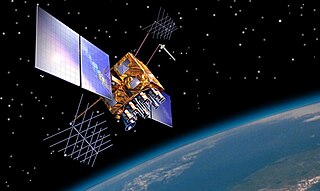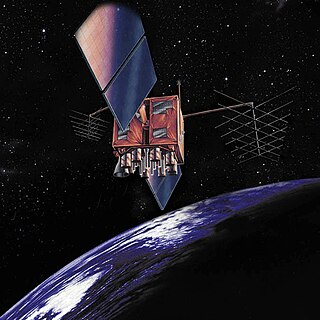
A geostationary transfer orbit (GTO) or geosynchronous transfer orbit is a type of geocentric orbit. Satellites that are destined for geosynchronous (GSO) or geostationary orbit (GEO) are (almost) always put into a GTO as an intermediate step for reaching their final orbit.

Delta II was an expendable launch system, originally designed and built by McDonnell Douglas, and sometimes known as the Thorad Delta 1. Delta II was part of the Delta rocket family, derived directly from the Delta 3000, and entered service in 1989. There were two main variants, the Delta 6000 and Delta 7000, with the latter also having "Light" and "Heavy" subvariants. During its career, Delta II flew several notable payloads, including 24 Global Positioning System (GPS) Block II satellites, several dozen NASA payloads, and 60 Iridium communication satellites. The rocket flew its final mission, ICESat-2, on 15 September 2018, earning the launch vehicle a streak of 100 successful missions in a row, with the last failure being GPS IIR-1 in 1997. In the late 1990s, Delta II was developed further into the unsuccessful Delta III, which was in turn developed into the more capable and successful Delta IV, though the latter shares little heritage with the original Thor and Delta rockets.

The Delta rocket family is a versatile range of American rocket-powered expendable launch systems that has provided space launch capability in the United States since 1960. Japan also launched license-built derivatives from 1975 to 1992. More than 300 Delta rockets have been launched with a 95% success rate. The series has been phased-out in favor of the Vulcan Centaur, with only the Delta IV Heavy rocket's last rocket launch due to occur in March 2024.

USA-201, also known as GPS IIR-19(M), GPS IIRM-6 and GPS SVN-48, is an American navigation satellite which forms part of the Global Positioning System. It was the sixth of eight Block IIRM satellites to be launched, and the nineteenth of twenty one Block IIR satellites overall. It was built by Lockheed Martin, using the AS-4000 satellite bus.

An apogee kick motor (AKM) is a rocket motor that is regularly employed on artificial satellites to provide the final impulse to change the trajectory from the transfer orbit into its final orbit. For a satellite launched from the Earth, the rocket firing is done at the highest point of the transfer orbit, known as the apogee.

USA-233, or Wideband Global SATCOM 4 (WGS-4) is a United States military communications satellite operated by the United States Air Force as part of the Wideband Global SATCOM program, launched in 2012. The fourth Wideband Global SATCOM satellite, it is the first WGS Block II satellite to be launched. It is stationed at 88.5° East in geostationary orbit.
The Star is a family of US solid-propellant rocket motors originally developed by Thiokol and used by many space propulsion and launch vehicle stages. They are used almost exclusively as an upper stage, often as an apogee kick motor.

USA-145, also known as GPS IIR-3 and GPS SVN-46, is an American navigation satellite which forms part of the Global Positioning System. It was the third Block IIR GPS satellite to be launched, out of thirteen in the original configuration, and twenty one overall. It was built by Lockheed Martin, using the AS-4000 satellite bus.

USA-150, also known as GPS IIR-4 and GPS SVN-51, is an American navigation satellite which forms part of the Global Positioning System. It was the fourth Block IIR GPS satellite to be launched, out of thirteen in the original configuration, and twenty one overall. It was built by Lockheed Martin, using the AS-4000 satellite bus.

USA-166, also known as GPS IIR-8 and GPS SVN-56, is an American navigation satellite which forms part of the Global Positioning System. It was the eighth Block IIR GPS satellite to be launched, out of thirteen in the original configuration, and twenty one overall. It was built by Lockheed Martin, using the AS-4000 satellite bus.

USA-175, also known as GPS IIR-10 and GPS SVN-47, is an American navigation satellite which forms part of the Global Positioning System. It was the tenth Block IIR GPS satellite to be launched, out of thirteen in the original configuration, and twenty one overall. It was built by Lockheed Martin, using the AS-4000 satellite bus.

USA-177, also known as GPS IIR-11 and GPS SVN-59, is an American navigation satellite which forms part of the Global Positioning System. It was the eleventh Block IIR GPS satellite to be launched, out of thirteen in the original configuration, and twenty one overall. It was built by Lockheed Martin, using the AS-4000 satellite bus.

USA-180, also known as GPS IIR-13 and GPS SVN-61, is an American navigation satellite which forms part of the Global Positioning System. It was the thirteenth of twenty one Block IIR GPS satellites to be launched, and the last in the original configuration. It was built by Lockheed Martin, using the AS-4000 satellite bus.

USA-183, also known as GPS IIR-14(M), GPS IIRM-1 and GPS SVN-53, is an American navigation satellite which forms part of the Global Positioning System. It was the first of eight Block IIRM satellites to be launched, and the fourteenth of twenty one Block IIR satellites overall. It was built by Lockheed Martin, using the AS-4000 satellite bus.

USA-190, also known as GPS IIR-15(M), GPS IIRM-2 and GPS SVN-52, is an American navigation satellite which forms part of the Global Positioning System. It was the second of eight Block IIRM satellites to be launched, and the fifteenth of twenty one Block IIR satellites overall. It was built by Lockheed Martin, using the AS-4000 satellite bus.

USA-192, also known as GPS IIR-16(M), GPS IIRM-3 and GPS SVN-58, is an American navigation satellite which forms part of the Global Positioning System. It was the third of eight Block IIRM satellites to be launched, and the sixteenth of twenty one Block IIR satellites overall. It was built by Lockheed Martin, using the AS-4000 satellite bus.

USA-199, also known as GPS IIR-18(M), GPS IIRM-5 and GPS SVN-57, is an American navigation satellite which forms part of the Global Positioning System. It was the fifth of eight Block IIRM satellites to be launched, and the eighteenth of twenty one Block IIR satellites overall. It was built by Lockheed Martin, using the AS-4000 satellite bus.

USA-203, also known as GPS IIR-20(M), GPS IIRM-7 and GPS SVN-49, is an American navigation satellite which was intended to become part of the Global Positioning System. It was the sixth of seven Block IIRM satellites to be launched, and the twentieth of twenty one Block IIR satellites overall. It was built by Lockheed Martin, using the AS-4000 satellite bus, and had a mass of 2,032 kilograms (4,480 lb).
Intelsat III F-2 was a communications satellite operated by Intelsat. Launched in 1968 it was operated in geostationary orbit at a longitude of 24 degrees west for around eighteen months.






